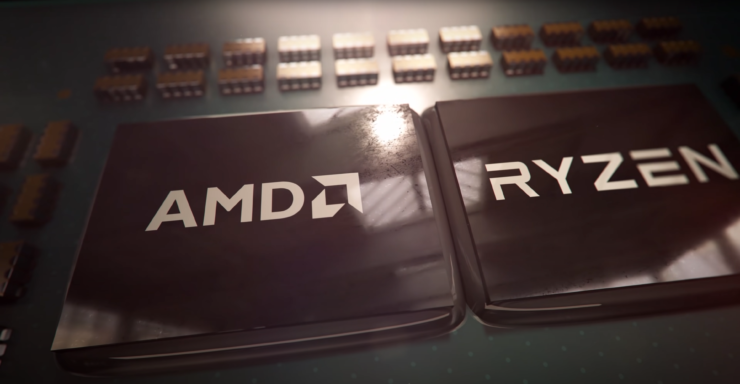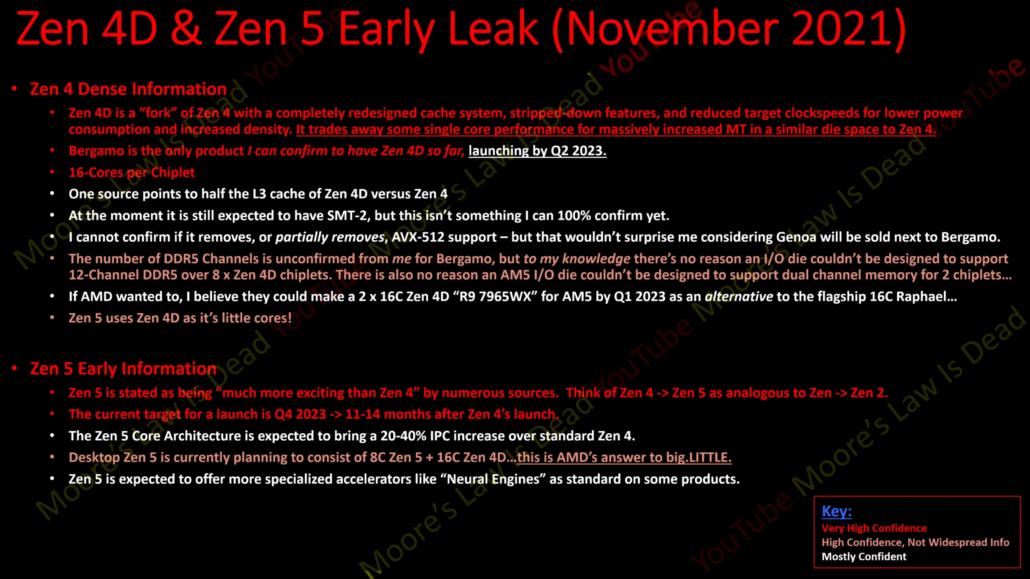
AMD Zen 4D or Zen 4 Dense chiplet design for next-gen Ryzen & EPYC CPUs has been detailed in a new video published by Moore’s Law is Dead. The leaker and insider reveals brand new on the core technology that will tackle Intel’s own hybrid architecture approach by 2023.
AMD Zen 4D ‘Zen 4 Dense’ CPU Architecture & Chiplet Design Detailed, Will Tackle Intel’s Hybrid Approach
The AMD Zen 4D chiplet design is said to be implemented in the next-gene Ryzen and EPYC CPUs but it will be first seen in action on the Bergamo lineup of server chips that are planned for launch in 2023. The approach is very different from Intel’s hybrid architecture that we will see on the Alder Lake line of chips. Both companies will feature two different core technologies on the same chip & with their own underlying cache design but AMD’s approach is more focused on maximizing multi-threaded performance over Intel’s efficiency approach.
It is stated that AMD’s Zen 4D cores will be a stripped-down version of the standard Zen 4 cores with a redesigned cache and few features. The cores are also said to feature lower clock speeds to hit power consumption targets but the main goal is to increase the overall core density. While Zen 4 will rock 8 cores per chiplet, Zen 4D will rock up to 16 cores per chiplet. This will allow AMD to up lift its core count on next-generation processors and also scale up its multi-threaded performance.
It also makes sense why this chiplet design is heading to the EPYC Bergamo CPUs first as AMD is intended to further increase its leading multi-threaded performance in the server field. The reason to strip down the majority of features is that Zen 4D 16 core CCDs will take up the same space as standard 8 core Zen 4 CCDs. So a Zen 4D chiplet with all the Zen 4 features will lead to a bigger die size. It is also mentioned that Zen 4D might feature half the L3 cache of Zen 4, may remove AVX-512 support, and SMT-2 support isn’t confirmed. That looks a lot like the Gracemont cores on the Alder Lake CPUs which also feature lower clocks, per core L3 cache, and don’t support SMT.
It is likely that AMD is going to segmentize their Zen 4D and Zen 4 chips with Genoa being the full-fledged Zen 4 design while Bergamo being a hybrid design. Genoa will feature AVX-512 as the leaked documents from Gigabyte revealed while Bergamo will be aimed at applications that require core density over AVX-512 support. The number of memory channels might also increase to 12-channel DDR5 with Zen 4D powered Bergamo CPUs and the same could be true for next-gen AM5 parts but that is currently not confirmed by MLID’s sources.
The same segmentation could also be seen in the next-gen Ryzen lineup with the standard Zen 4 powered Rapahel chips offering up to 16 cores while Zen 4D chips with up to 32 cores also launching as a soft-replacement for the Threadripper chips on the AM5 mainstream platform. We haven’t heard of any Zen 4D-based Ryzen family so far but AMD’s Strix Point APUs are expected to feature Zen 4D cores alongside Zen 5 cores in a more similar design approach to Intel’s Alder Lake.
AMD Mainstream Desktop CPU Generations Comparison:
| AMD CPU Family | Codename | Processor Process | Processors Cores/Threads (Max) | TDPs | Platform | Platform Chipset | Memory Support | PCIe Support | Launch |
|---|---|---|---|---|---|---|---|---|---|
| Ryzen 1000 | Summit Ridge | 14nm (Zen 1) | 8/16 | 95W | AM4 | 300-Series | DDR4-2677 | Gen 3.0 | 2017 |
| Ryzen 2000 | Pinnacle Ridge | 12nm (Zen +) | 8/16 | 105W | AM4 | 400-Series | DDR4-2933 | Gen 3.0 | 2018 |
| Ryzen 3000 | Matisse | 7nm (Zen 2) | 16/32 | 105W | AM4 | 500-Series | DDR4-3200 | Gen 4.0 | 2019 |
| Ryzen 5000 | Vermeer | 7nm (Zen 3) | 16/32 | 105W | AM4 | 500-Series | DDR4-3200 | Gen 4.0 | 2020 |
| Ryzen 6000 | Warhol? | 7nm (Zen 3D) | 16/32 | 105W | AM4 | 500-Series | DDR4-3200 | Gen 4.0 | 2021 |
| Ryzen 7000 | Raphael | 5nm (Zen 4) | 16/32? | 105-170W | AM5 | 600-Series | DDR5-4800 | Gen 4.0 | 2021 |
| Ryzen 8000 | Granite Ridge | 3nm (Zen 5)? | TBA | TBA | AM5 | 700-Series? | DDR5-5000? | Gen 5.0? | 2023 |
The Zen 5 cores are expected to bring up to 20-40% IPC increase over Zen 4 and will launch by the end of 2023 or early 2024. Ryzen chips based on AMD’s Zen 5 architecture are expected to rock up to 8 Zen 5 (3nm) cores and 16 Zen 4D (5nm) cores but that might be specific to the Strix Point APU lineup we mentioned above and not the Granite Ridge Ryzen CPUs that will replace Raphael. AMD is definitely interested in hitting Intel’s hybrid architecture approach in the future and besting them in their own game so look forward to more information regarding the latest AMD core technologies such as 3D V-Cache, Dense Zen chiplets, and more!
The post AMD Zen 4D ‘Dense’ Core For Next-Gen Ryzen & EPYC CPUs Detailed: Up To 16 Cores Per Chiplet, New Cache Design & Tackles Intel’s Hybrid Approach by Hassan Mujtaba appeared first on Wccftech.
